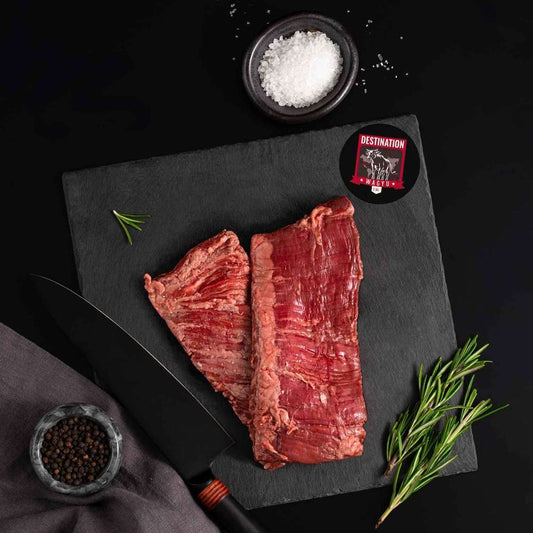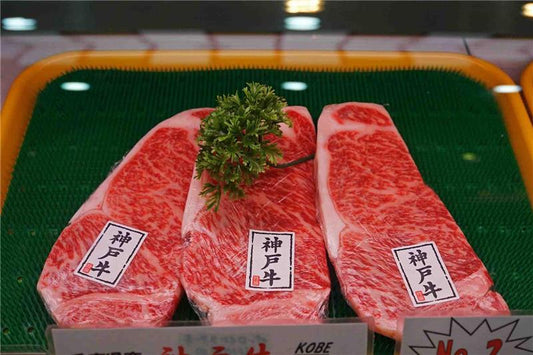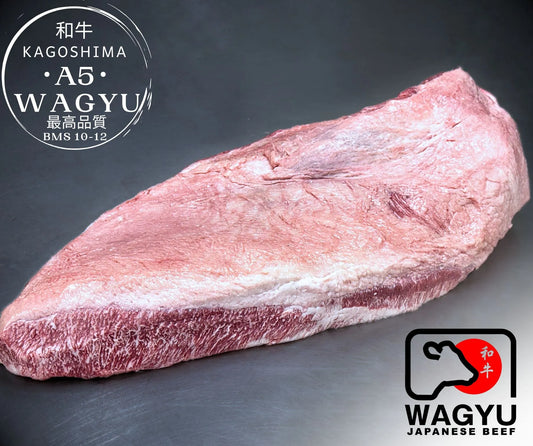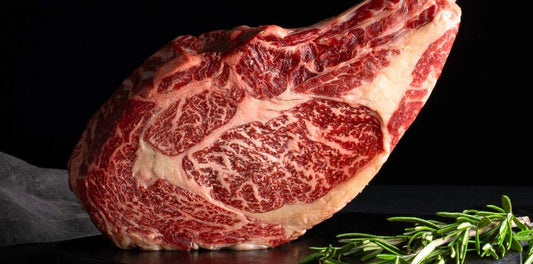-
Wagyu filet mignon’s low melting-point fat demands precise temperature control to preserve marbling integrity and achieve professional-grade texture.
-
Controlled searing and resting optimize Maillard reactions, fat retention, and flavor balance in restaurant-quality Wagyu skewers.
-
Consistent portioning, calibrated heat management, and disciplined mise en place enable repeatable fine-dining execution in home kitchens.
The Intersection of Craft and Accessibility
Creating restaurant-quality Wagyu filet mignon skewers in a home environment demands the same precision and reasoning you would apply in a professional kitchen. You are not simply working with a premium ingredient; you are managing a thermal and structural system. Every variable, from meat temperature to fat liquidity to surface moisture, must be intentionally controlled. The objective is to deliver the same harmony of texture, aroma, and flavor that defines fine dining, but within a smaller and more controlled setting.
The appeal of Wagyu lies in its unique fat matrix. When you pair that with the tenderness of filet mignon, you gain a platform that rewards precision. The skewer format allows you to standardize size, cook time, and heat exposure, which turns a simple preparation into a calibration exercise. You are not improvising; you are performing a deliberate sequence. Each movement affects the final sensory experience. The difference between a home cook and a professional here is not access to better equipment, but the discipline to repeat a controlled process.
To achieve professional-level results, you must integrate three fundamental principles:
-
Consistency in portioning, temperature management, and timing.
-
Scientific understanding of how Wagyu fat and protein respond to heat.
-
Visual and sensory precision in plating and service.
When you apply these consistently, your skewers cease to be a novelty. They become a precise expression of technique that reflects your control over both science and artistry.

The Science and Anatomy of Wagyu Filet Mignon
Breed and Grading Principles
Working with Wagyu means handling beef with a unique physiology unlike typical cattle. “Wagyu” refers to Japanese-origin breeds selectively bred for their exceptional intramuscular fat, creating rich marbling that delivers tenderness, buttery flavor, and a smooth texture. In the U.S., both purebred and crossbred Wagyu are available, each affecting cooking performance differently. Crossbred Wagyu generally has a firmer texture and higher fat-melting point, while pure Wagyu features a softer texture and more delicate, easily melting fat.
Grading standards are a critical factor in determining how you should handle the meat. The Japanese Beef Marbling Standard (BMS) ranks from 1 to 12, with higher scores indicating denser marbling and therefore greater delicacy in heat handling. By contrast, the USDA beef grading system tops out at Prime, which roughly corresponds to a BMS of 4 or 5. When you handle Wagyu with a BMS of 8 or higher, you must expect that the fat will begin to liquefy at extremely low temperatures. This means that heat control is not optional. It is the core of your strategy. Always calibrate your cooking plan according to the marbling grade. A higher grade demands shorter, sharper heat exposure and gentler resting conditions to avoid fat loss.
Fat Structure and Thermal Behavior
Wagyu’s defining trait is its unique fat structure. Its intramuscular fat melts at just 77–86°F (25–30°C), far lower than conventional beef. This low melting point creates a creamy mouthfeel and subtle sweetness but also makes Wagyu highly sensitive to temperature changes. Even minor shifts in room temperature or holding time can start breaking down the fat lattice. To preserve quality, keep Wagyu under controlled refrigeration until right before cooking, and avoid leaving it at ambient temperatures for long.
Once heat is applied, the goal is to promote controlled rendering. Fat should liquefy just enough to lubricate muscle fibers, not separate and drain. Professionals often use a two-stage process to achieve this: first, a controlled sous vide or low-temperature hold to bring the internal temperature evenly to around 53 to 54°C, followed by a rapid sear over a high-conductivity surface. This sequence allows for uniform internal doneness while still achieving the Maillard browning necessary for flavor. You can also achieve similar results on binchotan charcoal or a preheated cast-iron surface, provided you control timing precisely. Excess exposure will purge fat too early, leaving the meat dry and flat rather than rich and supple.
Muscle Composition and Texture Dynamics
The filet portion of the Wagyu carcass comes from the tenderloin, a muscle with minimal connective tissue and low activity. This anatomical feature creates its signature tenderness but also introduces challenges. The filet lacks collagen, so it cannot rely on long cooking or internal gelatinization to develop structure. Its appeal comes from the fineness of its fibers and the purity of its flavor. As a result, every bit of texture development must come from precise control of temperature and surface reaction rather than slow rendering.
To maintain the ideal texture, focus on the range between 50°C and 60°C where myofibrillar proteins denature and moisture movement occurs. Staying too long in this range causes water loss and a mushy texture. Moving through it quickly, followed by a short resting period, preserves juiciness and a silk-like bite. Uniformity is essential, so every skewer cube should be identical in dimension and mass. The cut direction also matters: aligning fibers perpendicular to the skewer minimizes resistance and allows even heat transfer. These details determine whether the finished skewer feels cohesive and tender or uneven and fatigued.
Ingredient Engineering: Beyond the Protein
Selecting the Wagyu
When you prepare Wagyu filet mignon skewers, ingredient sourcing is not a procurement step but a technical decision that determines how the dish will behave under heat. Your objective is to select meat that provides both structural integrity and predictable fat behavior. This requires understanding not only the grade but also the production method behind it.
You should verify three key details before purchase:
-
Lineage and certification: Use resources like the American Wagyu Association to confirm breeding standards.
-
Feeding regimen: Grain-fed cattle tend to produce softer, more aromatic fat, while grass-fed programs yield leaner and more mineral-forward meat. Choose based on your desired flavor architecture.
-
Aging process: Wet-aged Wagyu offers purity of fat aroma, while dry-aged Wagyu introduces oxidized depth and concentration. For skewers, dry aging beyond 30 days can enhance surface browning and umami intensity.
When you handle Wagyu, treat it as a system in equilibrium. Every variable you control at the sourcing stage simplifies the precision required during cooking. Always store the meat under strict refrigeration between 32°F and 36°F (0°C to 2°C) and temper it only briefly before searing. Excessive time at room temperature will compromise the marbling lattice, reducing fat retention and structural cohesion.
Complementary Components
A professional-level Wagyu skewer demands balance. The goal is to highlight, not mask, the beef’s intrinsic sweetness and depth. Complementary elements should amplify umami and texture without overwhelming the fat’s natural delicacy.
You should consider the following compositional principles:
-
Marinades and glazes: Keep salt content below 1.5% of total marinade weight to prevent pre-sear protein denaturation. A light blend of soy reduction, mirin, and rice vinegar provides salinity and acidity without compromising tenderness.
-
Oils: Use high smoke-point, neutral oils such as grapeseed, rice bran, or clarified Wagyu tallow for searing. These oils maintain clean Maillard development while reinforcing beef aroma.
-
Finishing salts: Opt for crystalline sea salts applied post-cook. Their delayed dissolution allows controlled salinity perception, ensuring the Wagyu’s natural sweetness remains dominant.
-
Acidic counterpoints: Incorporate minimal acid components like yuzu zest or pickled shallot to cut through fat saturation without destabilizing the texture.
A well-engineered accompaniment framework ensures the skewer remains centered on Wagyu’s identity. Every secondary ingredient must serve a structural or sensory function, not simply a decorative one.
Skewer Materials and Heat Transfer
The type of skewer you use directly affects the uniformity of cooking. Metal skewers conduct heat from end to core, accelerating internal cooking. Wooden or bamboo skewers insulate, producing a slower gradient. Your selection should match your heat source and cooking timeline.
-
Metal skewers: Ideal for controlled indoor searing or infrared heat sources. They promote internal heat conduction and help reduce gradient discrepancies.
-
Bamboo skewers: Suitable for charcoal or binchotan applications where the radiant energy is intense. Pre-soak them to prevent ignition and to maintain moisture stability.
-
Binchotan-grade skewers: Designed for high-precision yakitori-style operations. They maintain structural rigidity and absorb minimal grease, improving handling and plating hygiene.
In professional settings, skewers are chosen not for convenience but for predictability. Consistent heat transfer ensures repeatable doneness across all portions, which is essential when cooking multiple skewers simultaneously.
Technique Mastery: Building Restaurant-Quality Results
Precision Cutting and Portioning
Uniformity begins before cooking. Skewer cubes should be cut into consistent geometries that optimize both heat exposure and mouthfeel. A 25 to 35 mm cube provides the best compromise between sear area and internal control.
Best practices include:
-
Trim surface fat carefully while retaining inner marbling integrity.
-
Maintain even cube mass across all portions to ensure equal carryover heat.
-
Align the grain perpendicular to the skewer for consistent bite texture.
-
Chill briefly after cutting to restore firmness before cooking.
You should think of each cube as a unit of thermal potential. Identical mass and geometry create predictable internal conditions, allowing you to fine-tune sear duration with professional accuracy.
Temperature Profiling
To achieve restaurant-level precision, you must treat temperature as a variable to be engineered, not guessed. The optimal range for Wagyu filet skewers depends on balancing fat liquefaction with protein integrity.
Two effective approaches include:
-
Sous vide staging: Preheat to 53 to 54°C for 30 to 40 minutes. This stabilizes the core without initiating surface reaction. Immediately transfer to a high-heat environment for 30 to 45 seconds per side.
-
Direct sear method: Begin from refrigerator temperature on a surface exceeding 240°C. Flip frequently every 15 to 20 seconds to avoid thermal overshoot. Total cook time should not exceed 90 seconds for uniform coloration.
Both techniques rely on short, decisive exposure followed by controlled resting. Resting should last approximately two minutes, allowing residual heat to equalize internal gradients and reabsorb rendered fat. A professional will always monitor internal temperature using a fine-probe thermometer rather than relying on tactile judgment.
Surface Reaction Engineering
The Maillard reaction defines the flavor profile of a well-seared Wagyu skewer. Because filet has limited intrinsic flavor, your sear becomes the primary driver of complexity. Effective browning occurs in the temperature band between 140°C and 165°C at the surface, provided moisture has been adequately reduced.
For optimal results:
-
Pat each cube dry with absorbent paper immediately before cooking.
-
Avoid oil saturation prior to searing; excess oil will inhibit crust formation.
-
Maintain continuous movement to prevent localized charring.
-
Use a neutral fat medium, such as clarified tallow, to enhance browning without introducing competing aromas.
A controlled Maillard surface provides textural contrast and an aromatic envelope that balances the buttery nature of the interior. The art lies in achieving that crust without extending cook time beyond the fat’s stability threshold. Overdevelopment of the sear leads to harsh bitterness and ruptured muscle fibers, both of which reduce the perception of luxury.
Aromatic Integration
Smoke and aroma layering are essential to building dimension into Wagyu filet skewers. While the meat itself is highly aromatic, you can deepen the sensory complexity through selective exposure to clean-burning fuel sources.
Consider the following principles:
-
Introduce smoke at the end of the cooking process, not the beginning. Wagyu fat absorbs volatile compounds rapidly; early exposure can overpower its natural sweetness.
-
Use binchotan or fruitwood charcoal for a subtle aromatic lift. These sources generate steady, low-particulate smoke that complements rather than competes.
-
Allow 15 to 20 seconds of post-sear resting over low ember heat for aromatic adsorption.
When handled with restraint, this approach creates a layered sensory effect where aroma precedes taste. The result is a skewer that feels both delicate and complex, balancing technical precision with emotional appeal.

Flavor Architecture and Pairing Theory
Building Umami Synergy
Wagyu filet mignon delivers a rare combination of tenderness and depth, but to reach full sensory potential, you must build upon its intrinsic umami. True flavor architecture starts by understanding how glutamates and nucleotides interact with the Wagyu’s fat profile. Filet mignon, though tender, has lower myoglobin and inherent savoriness compared to other cuts. The role of umami amplifiers, therefore, becomes central to constructing a balanced flavor landscape.
You should design your accompaniments to enhance the Wagyu’s depth, not compete with it. Ideal pairings involve ingredients rich in natural glutamates, such as aged soy, miso, or mushroom reductions. A controlled application of these elements yields complexity without masking the beef. To execute this successfully:
-
Incorporate a micro-layer of fermented seasoning such as shiro miso glaze, applied in the final 10 seconds of searing.
-
Introduce earthy secondary umami sources like black garlic purée or shiitake concentrate for mid-palate depth.
-
Maintain restraint with salinity; the richness of Wagyu fat amplifies perceived saltiness.
The strategic use of umami not only enhances flavor but stabilizes the taste experience across temperature fluctuations. A well-balanced skewer should remain expressive even as it cools slightly on the plate, reflecting true restaurant-quality control.
Creating Textural Counterpoints
In high-level cookery, texture is flavor. A dish built entirely on softness lacks structure and dimension. For Wagyu filet skewers, the fat and tenderness dominate, so you must provide controlled counterpoints to engage the palate.
Consider incorporating:
-
Acidic relief: Elements like pickled daikon, yuzu-infused ponzu, or light citrus gel cut through richness and reset the palate.
-
Crisp or granular elements: Dehydrated shallot flakes or puffed rice offer contrast without weight.
-
Temperature variation: Pair warm skewers with cool accompaniments, such as cucumber-infused oil or micro-herb salad, to extend sensory interest.
When textural balance is achieved, each bite feels deliberate rather than indulgent. Your goal is to maintain momentum through contrast, ensuring the diner experiences clarity rather than saturation.
Beverage Pairing Considerations
Because Wagyu filet mignon is inherently rich, your beverage pairings should counterbalance fat with acidity, tannin, or carbonation. You should seek beverages that cleanse without overwhelming the subtle sweetness of the meat.
Recommended directions include:
-
Red wine: Opt for medium-bodied wines with bright acidity, such as Pinot Noir or Grenache. Avoid high-tannin varieties that dominate the finish.
-
Sake: A junmai daiginjo with clean minerality and soft fruit undertones complements Wagyu’s aroma and enhances umami resonance.
-
Beer or sparkling beverages: Light, dry lagers or brut-style sparkling wines refresh the palate and restore balance after each bite.
You are curating harmony, not contrast. The ideal pairing feels inevitable, as though the beverage was part of the cooking process itself.
Equipment Calibration and Environmental Control
Thermal Control Technologies
Your ability to produce restaurant-level skewers at home depends on how well you control temperature and heat consistency. Professional kitchens rely on calibrated infrared burners, carbon steel pans, or binchotan charcoal to manage heat flow. You should aim for comparable predictability by understanding your tools rather than replicating theirs.
For precision, consider the following options:
-
Cast iron or carbon steel pans: Provide stable, even conduction and develop strong sear characteristics when properly preheated.
-
Infrared burners: Deliver instant surface heat, useful for rapid crust development without prolonged exposure.
-
Charcoal setups: Offer unmatched aroma complexity. Use binchotan or fruitwood charcoal for consistent temperature and clean combustion.
Each heat source demands its own timing logic. Your responsibility is to develop repeatable benchmarks measured preheat duration, distance from flame, and resting sequence so that every batch of skewers performs identically.
Smoke and Fat Management
Wagyu’s high fat content makes it vulnerable to smoke contamination if managed improperly. When fat drips onto open flames or overheated surfaces, it vaporizes into acrid compounds that compromise aroma. To maintain clean flavors:
-
Keep surfaces clean between batches. Carbonized residue introduces bitterness.
-
If using a grill, maintain a cooler zone to divert drippings away from direct flame.
-
Deglaze pans periodically with a neutral spirit to release caramelized fond and restore balance.
Effective smoke control is a hallmark of professionalism. It ensures that the final aroma remains pure, defined by Wagyu’s intrinsic perfume rather than combustion artifacts. You should think of smoke as a seasoning measured, purposeful, and never accidental.
Plating and Service Strategy
Visual Geometry
Presentation is not ornamental; it guides perception. The arrangement of Wagyu skewers on the plate should communicate precision and restraint. Minimalism supports the concept of control and confidence in your craft.
You should structure plating according to these principles:
-
Linear arrangement: Align skewers parallel for visual clarity and ease of service.
-
Controlled negative space: Use plate area strategically to draw focus toward the product.
-
Color and material contrast: Neutral ceramics or dark slates highlight the marbling and glaze sheen of the beef.
A professional presentation emphasizes proportion, symmetry, and composure. Each visual choice reinforces the perception of technical mastery.
Temperature Retention and Timing
Temperature management does not end at the grill. Once removed from the heat, Wagyu’s low melting-point fat continues to shift. Service timing therefore, becomes critical to preserve mouthfeel and aroma.
For optimal results:
-
Rest skewers on a slightly elevated rack for one to two minutes to prevent steaming and moisture pooling.
-
Serve on pre-warmed plates around 110°F (43°C) to maintain heat without accelerating fat separation.
-
Coordinate service sequence so skewers reach the table within 90 seconds of plating.
Your responsibility is to synchronize cooking, plating, and service so that each bite represents peak condition. Any delay alters the texture and diminishes the expression of the meat. The success of restaurant-quality service at home lies not in equipment, but in timing precision.
Sensory Layering
A professionally executed dish engages multiple sensory channels simultaneously. You should consider the aroma, texture, and finish as part of a designed sequence rather than separate factors. The first impression comes from smell, the second from bite texture, and the third from lingering flavor.
To achieve this:
-
Allow skewers to rest briefly under a light aromatic veil, such as a sprig of charred rosemary or a wisp of citrus smoke.
-
Apply finishing salts or micro-acids immediately before service to trigger salivary response.
-
Maintain ambient silence or subdued sound at plating to heighten olfactory focus if serving guests in a private setting.
This final layer transforms a technical preparation into a complete experience. It is where the professionalism of execution meets the artistry of presentation.
The Professional Home Cook Mindset
Adopting Mise en Place Discipline
Executing premium cuts at a professional level in a home kitchen begins with mindset. Precision does not start with heat; it starts with preparation. Mise en place is more than organization; it is process control. When everything you need is measured, trimmed, and pre-positioned, you remove uncertainty and focus entirely on execution timing.
To translate this principle into your workflow, focus on the following professional standards:
-
Pre-stage all components: Prepare garnishes, sauces, marinades, and plating elements before the skewers touch the grill or pan.
-
Organize by cooking phase: Segment your station into clear zones: prep, sear, rest, and plate, mirroring a professional brigade system.
-
Control temperature transitions: Allow the skewers to reach near-room temperature before searing to ensure even doneness.
-
Time each stage with precision: Track sear duration and rest periods consistently; over-resting or under-searing compromises texture.
-
Protect workspace integrity: Keep tools, boards, and tongs clean and separated; sensory clarity and focus depend on visual order.
In Wagyu preparation, especially when working with premium cuts, this discipline becomes a flavor factor that translates structure into sensory excellence. Discipline in setup mirrors discipline in cooking, and both define true Wagyu craftsmanship.
Replicating Brigade Logic at Home
Professional kitchens operate on sequence and coordination. At home, you may be the only cook, but you can still replicate the structure of a brigade system. Each phase cutting, marinating, searing, plating should be treated as a separate station, with its own timing and quality checkpoints.
You can structure your solo workflow by adopting simple professional patterns:
-
Assign yourself time limits per phase. For example, no more than ten minutes for cutting and portioning, no more than ninety seconds for searing per batch.
-
Stage utensils and tongs in advance to avoid breaks in flow.
-
Use timers and thermometers rather than instinct for reproducibility.
-
Practice dry runs before hosting the service to refine timing.
This approach transforms cooking from improvisation into a controlled performance. When you internalize sequence logic, you elevate even small-scale operations into professional-grade experiences.
Consistency Framework
Your consistency framework is the feedback system that enables improvement. Every cook should record variables such as sear time, resting duration, and perceived flavor density. A simple log allows you to fine-tune parameters and replicate success.
Focus on measurable factors:
-
Cube size and mass: Standardize cuts to the gram for uniform heat penetration.
-
Surface temperature: Track preheat time and surface response to minimize variability.
-
Fat loss percentage: Weigh meat before and after cooking to monitor efficiency.
-
Sensory evaluation: Record tasting notes, focusing on aroma sharpness, texture gradient, and lingering finish.
By documenting results, you build a personal database of cause and effect. This iterative approach mirrors professional culinary R&D methodology.
Closing Thoughts: Redefining Domestic Fine Dining
Producing restaurant-quality Wagyu filet mignon skewers at home represents more than a culinary accomplishment; it is a redefinition of domestic fine dining. The process demonstrates that excellence is not limited to commercial kitchens but to environments where process, understanding, and discipline converge. When you approach your kitchen as a laboratory of control rather than convenience, you align with the same standards that guide professional chefs.
Luxury in this context is not excess but restraint. The most refined cooking avoids complication and focuses on purity of execution. You are not showcasing ingredients through quantity, but through integrity. Each skewer becomes a reflection of respect for the product and the science that allows it to reach its highest potential.
As you continue refining your method, think of each preparation as an opportunity to measure improvement. Precision replaces improvisation, clarity replaces clutter, and mastery replaces routine. The reward is not only in taste but in the quiet satisfaction of absolute control over your craft.

About Destination Wagyu
At Destination Wagyu, we believe restaurant-quality dining starts with exceptional ingredients. Our mission is to bridge the gap between professional kitchens and home tables by delivering Wagyu beef of uncompromising quality directly to you. Each cut from delicately marbled filet mignon to showstopping tomahawk is sourced from renowned producers like Miyazaki, Kobe Wine, Kagoshima, and Stone Axe. These partnerships ensure the highest standards of traceability, grading, and flavor integrity, empowering you to craft refined dishes like Wagyu filet mignon skewers with confidence.
Our curated collections, from signature gift boxes to custom subscription programs, are designed for those who demand excellence in every detail. When you cook with Destination Wagyu, you are not simply preparing a meal; you are engaging with the craftsmanship, heritage, and precision that define the world’s most luxurious beef.
If you are ready to elevate your next creation and explore the full potential of Wagyu in your own kitchen, we invite you to discover our premium selection and experience why we say with confidence: You Have Great Taste. Visit Destination Wagyu to begin your journey toward unmatched flavor and quality.








